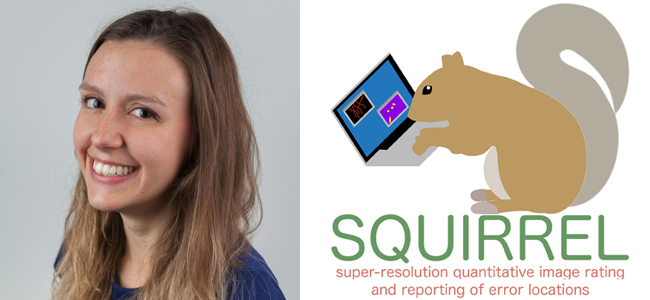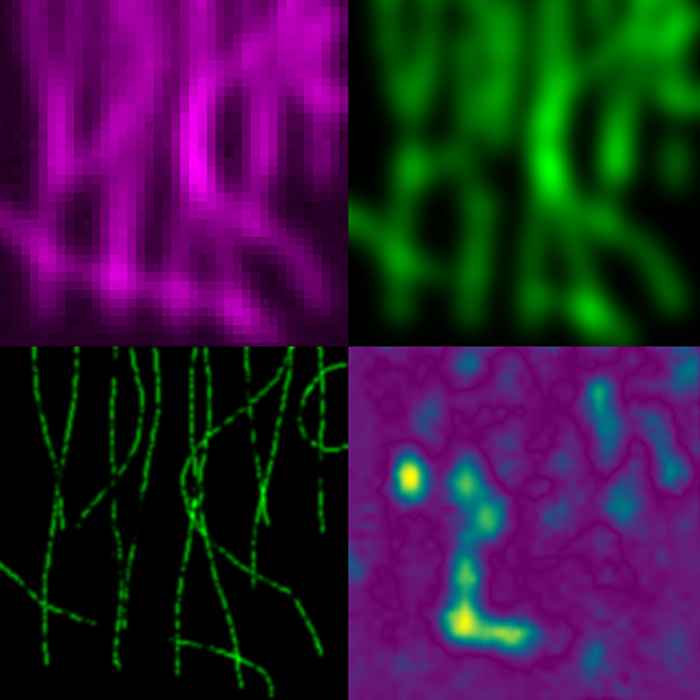Super-Resolution Microscopy: is your data nuts?
Congratulations to the Henriques Lab for their publication “NanoJ-SQUIRREL: quantitative mapping and minimisation of super-resolution optical imaging artefacts” in Nature Methods. We met with the lead author Siân Culley to talk about SQUIRREL, the motivation behind it, the publishing process, and, of course, the origins of SQUIRREL’s name.
Could you introduce the problem and tell us about NanoJ-SQUIRREL?
We all agree that microscopy is an indispensable tool in cell biology and researchers put a lot of trust in it. One of the problems of conventional microscopy is that the resolution of an image is limited by the diffraction of light and individual objects that are close together (under about 200 nm) appear as one single object when imaged. To tackle this, super-resolution microscopy techniques use complex optics and computational processing to get past this physical limit, in some cases achieving resolutions down to 20 nm. However, one big problem with super-resolution microscopy is trust. How much can you trust the images that you are getting out of these new microscopes? With conventional microscopy, you shine a light on your sample and you see it – there is no myth there, no trickery - it is very easy to believe. Once you add more processing and optical steps, then you wonder: “Is this tiny thing that I am seeing a real structure or is it some kind of artefact that the additional processing has introduced?”
What we aimed to do with SQUIRREL is develop a software tool to identify artefacts from super-resolution images by assigning a quantitative value to image quality. It is essentially a mathematical comparison of a super-resolution image with a conventional microscopy image of the same structure. The comparison generates an error map that tells you which parts of your super-resolution image agree with your diffraction-limited conventional image and which parts are deviating, suggesting they are less trustworthy. Quality readouts from SQUIRREL can also be used to optimize super-resolution imaging experiments. For example, in this study we show how SQUIRREL can be used to find the optimal number of frames needed to acquire a good quality STORM dataset or find the best algorithm for super-resolution image reconstruction. A lot of work also went into making SQUIRREL as simple as possible for the user. It’s a freely downloadable plug-in for FIJI and ImageJ; all you need to do is put in a diffraction-limited image and your super-resolution image and it will do all the hard work for you!
What was your motivation behind developing the software? Was there a need for something like this in the field?
I think super-resolution microscopy is not always used in biology as it should be, because people don’t fully trust the images that are produced. In publications, super-resolution images are almost always accompanied by diffraction-limited images, because the authors want to prove that the super-resolution image is trustworthy. We noticed this and saw a gap in the field for some kind of quality assessment. In addition, we wanted to challenge the way in which resolution is sometimes used as a proxy for image quality. It often seems that citing an image has very high resolution implies that the work was done at a high standard. However, whilst developing the software we actually found that high resolution does not necessarily mean that the image is of good quality and vice-versa. SQUIRREL allows you to map resolution across parts of your image and compare it to the error-map. Thus, rather than assuming high resolution correlates with a good quality image, you have confirmation that the image is trustworthy.
That’s great! Now let’s address the question on everyone’s mind- why the name SQUIRREL?
SQUIRREL is a wonderful acronym, which came out of a bout of insomnia. We pretty much had the software ready to go with a boring placeholder name but wanted something slightly “jazzier”. One night I couldn’t sleep and decided to write down all the words associated with the algorithm. And there it was: Super-resolution Quantitative Image Rating and Reporting of Error Locations - SQUIRREL! I then designed a logo of a squirrel doing some image processing, which felt like the obvious next logical step. The next day, Ricardo’s reaction was: “We’re not calling it SQUIRREL, we are 100% not calling it SQUIRREL”. My response was to challenge him to think of something better and put it to a vote on Twitter. Of course, SQUIRREL won by a country mile, so it was a very democratic process. The super-resolution community loves an acronym and I quite like SQUIRREL, it’s squirreling away, digging up your errors.
siansquirrel.jpg
 No float
No float Siân and her insomnia-fueled SQUIRREL logo
Could you tell us a bit about how the publication process happened because it’s quite unique?
The super-resolution microscopy community is quite active on Twitter and a lot of resources are shared online pre-publication. With this in mind, we wanted the community to try SQUIRREL out and provide us with feedback before sending the paper off for publication. We wrote up the software with some examples as a bioRxiv manuscript and released the plug-in for a couple of weeks to see what the community thought of it and whether they had any feedback or suggestions. The bioRxiv manuscript generated a lot of interest online which prompted a journal editor to invite us to submit the paper. We had already done a lot of validation for the bioRxiv manuscript and written it as close to peer review standard as possible, so we submitted the paper and they liked it! It was great to get feedback from the community and it was like having free beta testers and peer reviewers before the actual peer review process.
What are you currently working on and what is in store for SQUIRREL in the future?
One of the things we are working towards is the development of adaptive microscopy. Imagine a future where your smart microscope runs SQUIRREL in parallel to microscopy acquisitions. It will look at the error maps and quality metrics and adjust the imaging parameters to get the best possible image without any user input. In most types of microscopy, whether super-resolution or not, a lot of the time you’re guessing - guessing what laser power you should use, the exposure time or how many time-points you should be taking. If we have a way of ascertaining the quality of an image, then we can relay this information back to the microscope and instruct it to adjust the parameters of acquisition. Ironically, that’s the dream - to replace me with a smart microscope that can do my job and make me entirely redundant!
Thank you for your time! Looking forward to reading your paper!
This study was supported by the Medical Research Council, Biotechnology and Biological Sciences Research Council, European Research Council, Wellcome Trust, Centre National de la Recherche Scientifique, a Marie Curie fellowship and a Commonwealth scholarship. If you’re “nuts” about super-resolution microscopy and want some help digging up imaging artefacts, you can download the SQUIRREL software from here as a plug-in for FIJI or ImageJ. You can also follow Siân and the Henriques Lab on Twitter, and maybe have your say in naming their next project!
Interview by Gemma Wilson and Delyan Mutavchiev
 Close
Close


